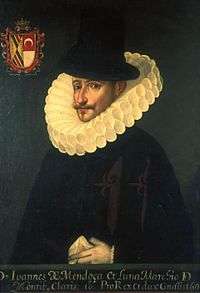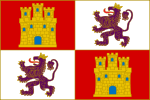Juan de Mendoza, 3rd Marquis of Montesclaros

Don Juan de Mendoza y Luna, 3rd Marquis of Montesclaros (Spanish: Juan de Mendoza y Luna, marqués de Montesclaros, or sometimes marqués de Montes Claros) (January, 1571, Guadalajara, Spain – October 9, 1628, Madrid), Spanish nobleman, man of letters, and the tenth viceroy of New Spain. He governed from October 27, 1603 to July 2, 1607. Thereafter he was viceroy of Peru, from December 21, 1607 to December 18, 1615. After returning to Spain, he became advisor to the king and a high official in the Court.
Youth and early career
Juan de Mendoza y Luna was the posthumous son of the second Marqués de Montesclaros. He was raised by his mother, Isabel Manrique de Padilla.
He served with distinction in the army of the Duke of Alba in the Portuguese campaign, as a captain of lancers. For his service, he was awarded the Order of Caballero de Santiago in 1591. Later he was governor of Seville, where he first became acquainted with the affairs of the Indies. On May 19, 1603 the Crown named him viceroy of New Spain.
As viceroy of New Spain
He made his formal entry into Mexico City on October 26, 1603, accompanied by his wife Ana de Mendoza, and assumed the reins of government. He immediately accused his predecessor, Gaspar de Zúñiga y Acevedo, Count of Monterrey of excessive spending and of exceeding his authority. Plans to colonize Alta California in the wake of Sebastián Vizcaíno's exploration were cancelled.[1]
In August 1604 there was another major inundation of Mexico City. Damage was extensive. The viceroy initially suggested moving the capital to the nearby hills of Tacubaya, but this was deemed too expensive. Then he decided to finish the drainage canal of Huehuetoca, but this was a project requiring many years and the labor of 15,000 Indians to complete. In the meantime he repaired the dikes constructed under Viceroy Luis de Velasco, at the same time paving the streets of San Antonio Abad, Chapultepec, San Cristóbal and Guadalupe. Nevertheless, parts of the city remained submerged for a year.
Mendoza y Luna also constructed an aqueduct on stone arches that conducted water from the springs on Chapultepec to the center of the city. He cleaned the water channels and paved many streets with cobbles.
He lifted restrictions on Indians returning to their land to live.
Later career and death
On November 20, 1606, Mendoza y Luna was named viceroy of Peru, with instructions to remain in New Spain until the arrival of his successor. The new viceroy, Luis de Velasco, marqués de Salinas, arrived in July of the following year, and Mendoza sailed from Acapulco for Lima in that month.
He served as viceroy of Peru until 1615. During his government in Lima the famous Stone Bridge and the Alameda de los Descalzos of that city were built. He returned to Spain the following year, and served as counselor of state and of war. Subsequently he was president of the council of Hacienda (treasury), and also of the council of Aragon. In 1621 King Philip IV made him a grandee of Spain.
He died in Madrid in 1628, at the age of 57.
References
- ↑ http://www.sandiegohistory.org/journal/78winter/plans.htm PLANS FOR THE OCCUPATION OF UPPER CALIFORNIA A NEW LOOK AT THE "DARK AGE" FROM 1602 TO 1769, The Journal of San Diego History SAN DIEGO HISTORICAL SOCIETY QUARTERLY, Winter 1978, Volume 24, Number 1
- (Spanish) García Puron, Manuel, México y sus gobernantes, v. 1. Mexico City: Joaquín Porrua, 1984.
- (Spanish) Orozco L., Fernando, Fechas Históricas de México. Mexico City: Panorama Editorial, 1988, ISBN 968-38-0046-7.
- (Spanish) Orozco Linares, Fernando, Gobernantes de México. Mexico City: Panorama Editorial, 1985, ISBN 968-38-0260-5.
External links
| Wikimedia Commons has media related to Juan de Mendoza y Luna. |
| Government offices | ||
|---|---|---|
| Preceded by Gaspar de Zúñiga y Acevedo, Count of Monterrey |
Viceroy of New Spain 1603–1607 |
Succeeded by Luis de Velasco, marqués de Salinas |
| Preceded by Diego Núñez de Avendaño |
Viceroy of Peru 1607–1615 |
Succeeded by Francisco de Borja y Aragón |

